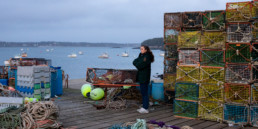Making It Here: The Island Educator
Monhegan’s one-room school teacher turned her back on New York City.
By Kathy Westra
The first time Monhegan Island’s teacher, Mandy Metrano, laid eyes on the island she now calls home, she was not impressed. In 1995, as an 18-year-old high school student on a visit to see her boyfriend, a summer resident, she saw Monhegan as “all ocean and dirt roads and nothing happening. The only evidence of nightlife was a bunch of kids playing Hacky Sack under the island’s only street light,” she remembers.
A year later, her boyfriend had lined up a summer job waiting tables at Monhegan House, but Metrano had planned to spend her own summer break traveling to India with a friend. When the trip fell through, her boyfriend, Jon, suggested she work with him on Monhegan instead.
This time, the island stole her heart the day she arrived.
“We took the early boat and even when we got close, we couldn’t see the island because it was so foggy. We could hear the foghorn, though, and as we approached the dock in the fog I heard bagpipes. It was magical.”
The end of that day was equally enchanting. Walking back to the ferry dock at sunset, she and Jon saw a young buck standing at ease among apple trees filled with hummingbird moths against a backdrop of “the most amazing painted sky with the sun setting behind Manana (Island).”
After that day, “Monhegan became part of me, gnawing at me, wanting me back,” Metrano confesses. She didn’t come back immediately, though. She spent some time in Portland, doing marketing work for a small natural products company. Then she landed a sales job with a natural products distributor in New York City. It was not a good place for a young woman whose heart was firmly planted on an island off the coast of Maine.
“I was depressed. I had no medical insurance. I had a sinus infection that lasted six weeks. One day I read my horoscope in the Village Voice and it said: ‘The material world is eating away at your sense of happiness.’ That was it. I thought: What am I doing here in New York? I need to go back to Monhegan.”
A week later, she was back on the island, working again in the dining room at Monhegan House. It took only a month to realize she was not going back to New York.
“All of my stress and anxiety had just melted away. When you’re surrounded by this vast ocean, your perspective changes.

Metrano lived on Monhegan year-round from 2003 to 2005, working in the café at the Trailing Yew in the summer, and serving as the sternman on a lobster boat in the winter, a job for which she had no training but which she learned quickly.
“That was the hardest physical work of my life,” she says. “I loved being out on the water, and got very strong.”
Her first time working in a classroom was in 2004-05, when she combined her job on the lobster boat with work assisting Sarah Caban, then the teacher at the island’s one school.
“Sarah needed an ed tech and hired me. She was a great role model. She was a really compassionate, organized, creative teacher with lots of energy who was able to meet each student at their personal level of learning.” Since becoming the island’s sole teacher three years ago, that’s something Metrano has incorporated into her own practice, and it’s noticed and appreciated by the islanders.
Winnie Murdock, who has lived on the island with her husband John for 40 years, has high praise for Metrano. Murdock’s children went to the island school and now her four grandchildren attend it.
“What’s really special about Mandy is how willing she is to meet each student where he or she is. That’s her greatest strength and what makes her such a perfect fit (for the small, multi-grade school),” she said. “The success of an island school is totally dependent on the teacher. If you have a good teacher like Mandy, you have a good school. We all feel really lucky to have her.”
Although she and her classroom assistant, Nancy Vogt, are the only educators on Monhegan, Metrano gets to interact with teachers from five other island schools through the Island Institute’s Outer Islands TLC (Teaching and Learning Collaborative). That group holds bimonthly meetings, and the teachers collaborate on science and social studies curricula and teach each other’s students in virtual book groups. “They are a lifeline,” says Metrano of the other teachers. “It’s a very supportive and helpful group.”
She finds the flexibility of teaching in the one-room, multi-age school liberating. “Sometimes I think it would be easier if someone just handed me a curriculum and said, ‘Here you go,’” she says. “But the truth is, the kids lead me to how we’re going to learn about something, and I’m amazed at the empathy and leadership that develop spontaneously when older students learn and play with younger students.”
Metrano, now 40, lives with her husband on the island all year, teaching full-time during the school year and working at the front desk of the Island Inn during the summer.
Although she loves living on the island, she concedes that island living has its challenges, one being that whenever she does get to the mainland, her limited time there is so crammed with things to do—errands and visiting family and friends—that she often feels she doesn’t have enough time to make deeper connections with the things and people that are important to her on the mainland.
Asked if she envisions this life as a long-term plan, Metrano says she and her husband “are taking it one year at a time.” Right now, she is exactly where she wants to be.
“I have not ever been bored as a teacher. Every day is different. I am always facing new challenges and learning new things. The real question will be if I have given the kids what I have to offer and it’s time for someone else to share their unique gifts and teaching style with the island kids. If I start to bring repetitive, uninspired ideas to the table then it will be time to change it up.”






